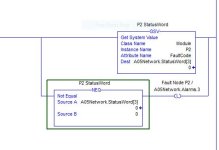papacroft
Member
I'd like to be able to detect if the Ethernet Comms falls over between my PLC Ethernet card and any of the 5 PF525 inverters I have connected to it.
There's some data types - module defined members e.g Faulted, Ready, Active etc. There's one call CommFreqCnt, but not sure what that's for. Any advice much appreciated on a way to detect falling over.
(Background: The Ethernet card is 1756-ENBT/A connected to a managed cisco switch which connects to an unmanaged switch which has the 5 inverters.
Basically after improving robustness, so that I can issue a shutdown of system if I have a comms failure to an inverter...
Thanks in advance.
There's some data types - module defined members e.g Faulted, Ready, Active etc. There's one call CommFreqCnt, but not sure what that's for. Any advice much appreciated on a way to detect falling over.
(Background: The Ethernet card is 1756-ENBT/A connected to a managed cisco switch which connects to an unmanaged switch which has the 5 inverters.
Basically after improving robustness, so that I can issue a shutdown of system if I have a comms failure to an inverter...
Thanks in advance.






